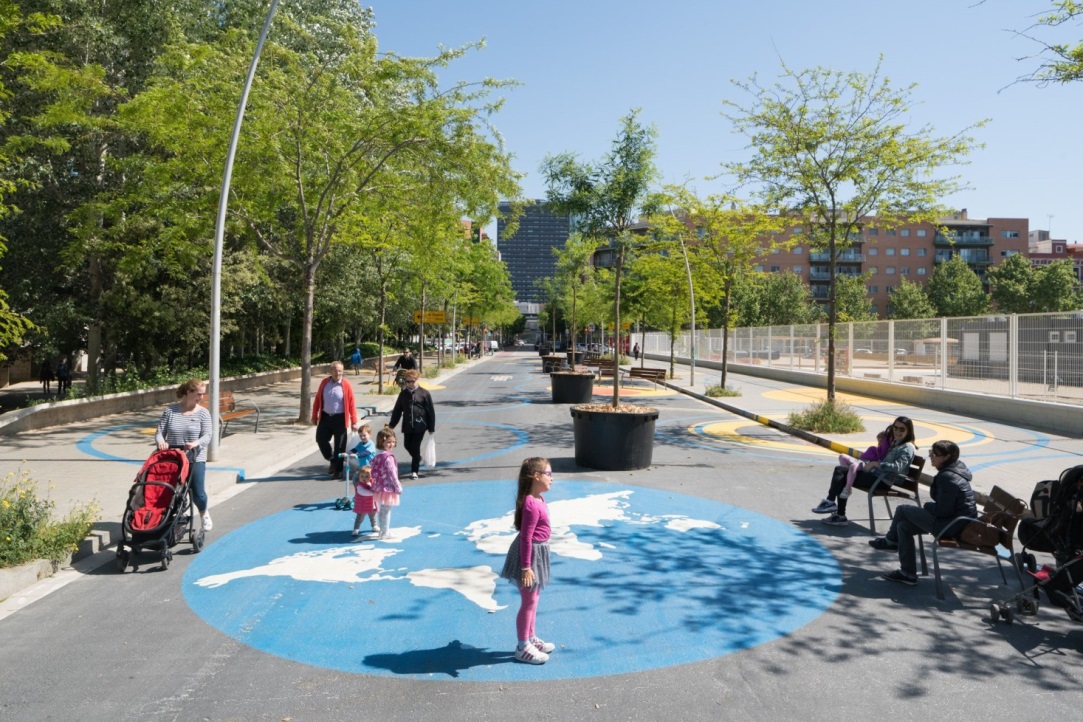- Home
- / Latest news
- / Gaining a million square metres from cars with the Barcelona Superblock plan
Gaining a million square metres from cars with the Barcelona Superblock plan
06/10/2021 - 17:25 h
The Barcelona Superblock plan should reconvert a million square metres of road surface into space for local people, fostering neighbourhood life and creating new green areas, driving sustainable mobility and favouring commerce, restaurants and local industries. A new interactive map enables users to see the projects already executed and those planned through until 2023.
The Barcelona Superblock plan means a change in the urban planning model to achieve a more sustainable and resilient city.
Transformation of large spaces
Various superblocks have been created to help local people get around and lead healthier lives, in neighbourhoods such as Poblenou, Sant Antoni and Hostafrancs. Elsewhere, work is under way to transform C/ Consell de Cent into a street with squares and to generate green streets, for Av. Meridiana to cease to be an urban motorway, for Pl. Glòries to become a new green lung and for Via Laietana to be a street for adjacent neighbourhoods rather than a through road for traffic.
Besides these major transformations, the city is being adapted so that 75% of its roads have 30 km/h speed limits. In addition, calming measures for secondary roads in neighbourhoods offer priority for pedestrians and cyclists, incentivising healthier mobility.
A city for children
The street-calming measures in areas around schools mean fewer traffic lanes and more space for children and their families to get together before and after school, favouring well-being for a particularly vulnerable group.
Many schools are also being turned into climate shelters to tackle the effects of the climate emergency.
At the same time, new play areas which are better integrated into the city and more diverse are gradually turning Barcelona into a city to play in. To this end, singular play elements are being introduced which stimulate children’s imagination and interaction with nature, along with options which are accessible to all.
Efficient and environmentally friendly mobility
The urban transformation and its street-calming measures give priority to journeys made on foot or by bike. The prevision is also to expand the public transport network and make it more efficient through various measures, such as a 10% increase in the speed of buses.
Autumn also brings the start of work to recondition Av. Diagonal, a prelude to the extension of the tram system along the avenue from Glòries to Verdaguer, strengthening connections between L’Eixample and the metropolitan area.
The cycling infrastructure is also moving forward, with 97 new Bicing stations now in service and the ongoing citywide roll-out of the bike lane network.
More flats to double the public housing stock
To protect neighbourhood life and preserve the right to housing, 6,100 public homes have either been built or are in the pipeline, along with the acquisition of nearly 1,000 flats.
The goal is to double the current stock of affordable publicly owned homes.
Urban planning which fosters the local economy
Urban projects to foster the local economy include the new regulation to consolidate terraces on road surfaces, the transformation of uses at the Olympic Port, moving towards nautical-based activities, and the promotion of a new research and innovation hub in the area around La Ciutadella.
New interactive map
Work from the Barcelona Superblock plan which has already been completed, is under way or due to be implemented in the period through to 2023 can be found on the new interactive map.
Once these projects are completed, a million square metres of asphalt will have been given over for use by local people and 40 hectares of new greenery added. The idea behind the measures is for 81% of journeys in the city to be made on foot, by bike or on public transport.
- Detall zenital d’una àrea de jocs infantils de la Superilla del Poblenou




